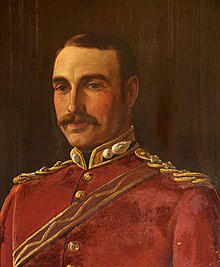Loading AI tools
British soldier, historian and archaeologist From Wikipedia, the free encyclopedia
Colonel Sir Joseph Alfred Bradney, CB DL JP FSA (11 January 1859 – 21 July 1933) was a British soldier, historian and archaeologist, best known for his multivolume A History of Monmouthshire from the Coming of the Normans into Wales down to the Present Time.
Joseph Alfred Bradney | |
|---|---|
 Bradney as a lieutenant of the Royal Monmouthshire Royal Engineers Militia in 1885. | |
| Born | 11 January 1859 Greet, Tenbury Wells, Shropshire, England |
| Died | 21 July 1933 (aged 74) Monmouth, Monmouthshire, Wales |
| Allegiance | |
| Service | |
| Years of service | 1882–1918 (36 years) |
| Rank | Colonel |
| Commands |
|
| Battles / wars |
|
Joseph Bradney was born at Greet, Tenbury Wells, Shropshire, and educated at Harrow[a] and Trinity College, Cambridge.[2] He acquired, partly by inheritance and partly purchase, Tal-y-coed Court,[b] an estate at Talycoed, Llanvihangel-Ystern-Llewern, near Monmouth, where he settled at an early age.[4] He entered the army, serving as captain of the Royal Monmouth Royal Engineers Militia from 1882 to 1892, and lieutenant-colonel commanding the 2nd Battalion, Monmouthshire Regiment from 1892 to 1912.[3] In the Territorial Force Reserve from 1912 to 1919, he served in France in 1917–18, despite being 57 years old.[c][5][6] In contravention of the King's Regulations, Bradney kept a diary throughout his period of active service.[7][d]
Bradney was High Sheriff of Monmouthshire in 1889, Deputy lieutenant of the county, and a county councillor from 1898 to 1924.[10] He was also a governor and on the Council of the National Library of Wales and the National Museum of Wales. He was a member of the Royal Commission on the Ancient and Historical Monuments of Wales. He was appointed a Companion of the Bath in 1911, and knighted in 1924.[5][11]
He wrote extensively on the history of Monmouthshire, his major work being A History of Monmouthshire from the Coming of the Normans into Wales down to the Present Time, published in twelve volumes between 1904 and 1933.[12][13] A final volume, drawing on his notes, was published posthumously. The books have been described as a "monumental survey, extensively illustrated and containing dozens of pedigrees, [which remains] a basic reference work essential for the serious study of local history or genealogy in Monmouthshire." He shared an interest in vulgar limericks with the antiquarian Egerton Phillimore though Bradney's letters to Phillimore were often written in Latin.[14]
He was married twice, first to Rosa Jenkins (d. 1927), with whom he had three sons and two daughters,[6] and then to Florence Prothero.[11] A Latin tablet in the Church of St Michael and All Angels, Llanvihangel-Ystern-Llewern records his achievements.[15]
Bradney's History comprised twelve volumes, divided by the traditional administrative areas of Hundreds. The work covered six of the seven hundreds of Monmouthshire.
Between 1991 and 1993, the history was reprinted by Academy Books, and subsequently the Merton Priory Press, as an 80% sized facsimile. The work was arranged slightly differently to the original history. The indices were included in their respective Parts and a fifth volume, which covers the last Hundred of Newport, was compiled from Bradney's manuscripts by medieval historian Dr Madeleine Gray.[25] The re-ordered works were:
Volume 5 contains an Introduction by Dr Gray which includes a biography of Bradney, her response to the criticism of his History of Monmouthshire by local historian Canon E.T. Davies[e] and her critique of Bradney's writings.
Seamless Wikipedia browsing. On steroids.
Every time you click a link to Wikipedia, Wiktionary or Wikiquote in your browser's search results, it will show the modern Wikiwand interface.
Wikiwand extension is a five stars, simple, with minimum permission required to keep your browsing private, safe and transparent.